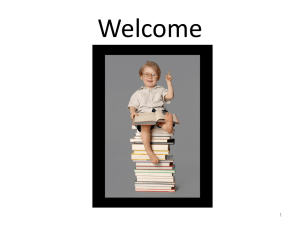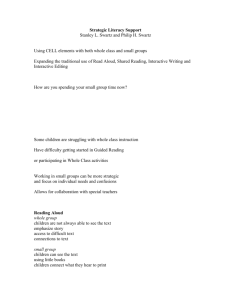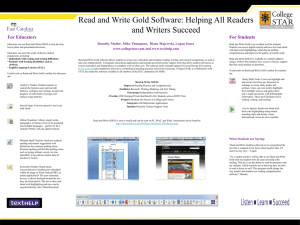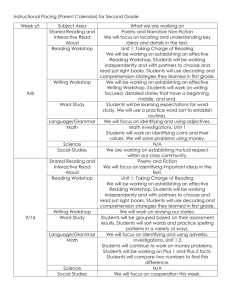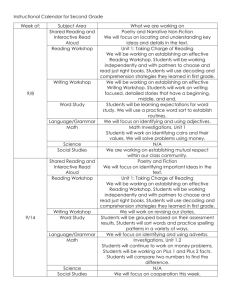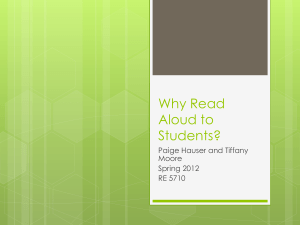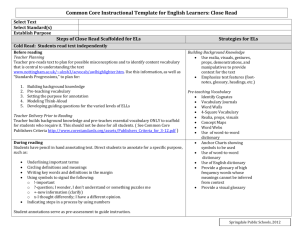Balanced Literacy Overview
advertisement
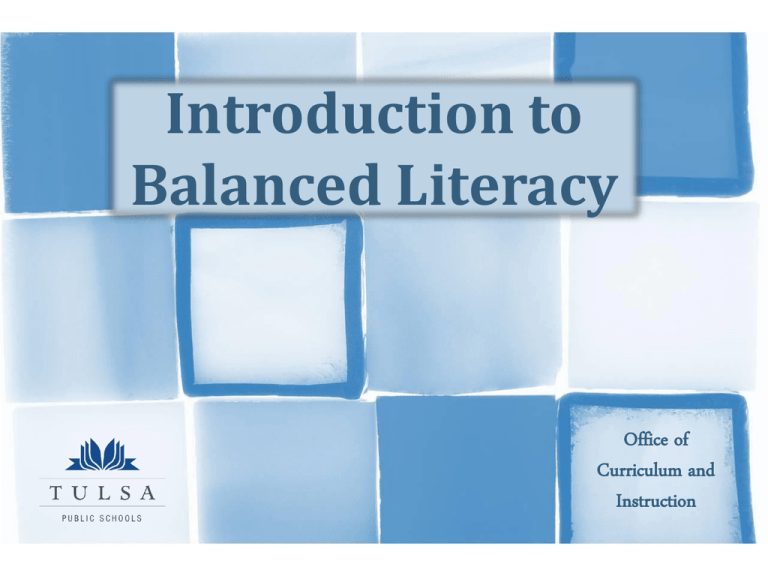
Introduction to Balanced Literacy Office of Curriculum and Instruction Components of a Balanced Literacy Block Read Aloud Whole Group Shared Reading Small Group Guided Reading Independent Reading Writing Word Study I Do – We Do- You Do Fisher and Frey, 2007 Read Aloud • Teacher reads and models comprehension skills while students listen. • 10-15 minutes Read Aloud Research • To build knowledge for students’ eventual success, the single most important activity is reading aloud to them. • Reading aloud to children increases language and literacy development when teachers are intentional and purposeful about – WHY they read, – WHAT they read, and – HOW they read. • Teachers can make a large difference in children’s vocabulary development when they explain and discuss important new words during read alouds. • Reading aloud interactively builds comprehension. It has maximum learning potential when children participate actively and respond. Read Aloud Research, continued • Children whose parents have not read to them often enough will not develop the same knowledge of written language and how it differs from oral language. • Teachers can develop this knowledge in students by reading aloud to them in the classroom. Read Aloud Advantages • • • • develop positive attitudes toward reading increase enjoyment of reading strengthen cognitive development instill a sense of story structure and organization Discussion Notes: How does purposeful pre-planning of your Read Aloud improve student learning? Whole Group Shared Reading • Teacher guides a wholegroup reading of the text. • 20-30 minutes Whole Group Shared Reading: The Focus • • • • Build book and print awareness Activate background knowledge Provide direct instruction of vocabulary Provide direct instruction of comprehension strategies with grade-level text • Provide instruction and repeated practice in decoding • Increase reading accuracy and fluency • Engage students in choral reading, echo reading, and reader’s theater Small Group Guided Reading • Teacher guides small-group reading of the text while other students engage in meaningful practice of literacy skills. • 40-60 minutes Small Group Guided Reading: Framework • Students practice comprehension strategies and decoding with instructional-level text (text they can read at 90-94% accuracy). • Groups are flexible and needs-based (data) – Book and print awareness – Phonics skills – Reading accuracy and fluency – Reading comprehension • Other students work independently or with partners on literacy tasks to practice and consolidate skills previously taught. – How will the practice propel students forward as readers? – On which task does each student need to work to become more prof – Are students able to do the activity independently? “When an adult and a child or group of children spend unhurried and uninterrupted time viewing, reading and sharing a book together, the unspoken messages about reading and about books are as important, and perhaps longer lasting, than any part of the actual content.” Margaret Mooney, Shared Reading: Making it Work for You and Your Children (1994) Discussion Notes: How are Whole Group Shared Reading and Small Group Guided Reading different? Independent Reading • Students engage in independent reading while the teacher monitors and conferences with students. • 15-20 minutes Independent Reading Research • The amount of time students spend reading independently is the best predictor of • reading achievement • the amount of gain made by students between second and fifth grades. • Students who begin reading a book in school are more likely to continue reading outside of school. Anderson, Wilson, and Fielding (1988) Independent Reading Structure • While reading independent-level texts (>95% accuracy), students apply their decoding and comprehension skills without teacher guidance. book and print awareness phonics accuracy fluency comprehension • Students in upper elementary grades benefit from tracking their thinking and monitoring comprehension through writing. • Teachers can identify students’ needs by conferencing with students and administering assessments. Correlation Between Time Spent Reading and Standardized Test Results Percentile Rank 98 90 70 50 20 10 Minutes Read per Day Estimated Words Read per Year 90.7 40.4 21.7 12.9 3.1 1.6 4,733,000 2,357,000 1,168,000 601,000 134,000 51,00 Dr. David Bennett, Chicago Rush Universit Word Study • Teacher leads instruction in word patterns. • 20 minutes Word Study: The Focus • Must be explicit and systematic • Focus on phonological awareness – Rhymes, syllables, onsets/rimes • Focus on phonics – Letter-sound correspondence, patterns, and decoding skills • Include analysis of word structures – Contractions, inflected endings – Homophones, syllable types – Prefixes, suffixes, Greek and Latin roots Discussion Notes: How does Word Study compare to traditional spelling instruction? Writing • Teacher guides students through a focused writing process. • 30-60 minutes Writing Research • Although handwriting and correct spelling are skills children must eventually master, these are not the focus when we engage children in writing. • Instead, we should focus on writing as a form of communication. Neuman, Roskos, Wright, and Lenhart (2007) Writing: The Structure Components: Mini-lessons Shared Writing Independent Writing Conferencing Focused Process Writing: -Provides explicit instruction for specific genres of writing -Includes pre-writing, drafting, revising, editing, Use the writing process for two purposes: publishing • Mechanics (sound-symbol relationships and English language conventions) • Content (communicating ideas, messages, and stories) Contact Information If you have additional questions about the balanced literacy overview you may contact: wicklo@tulsaschools.org Natalie Hutto: huttona@tulsaschools.org Ayn Grubb: grubbay@tulsaschools.org

